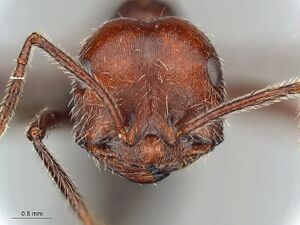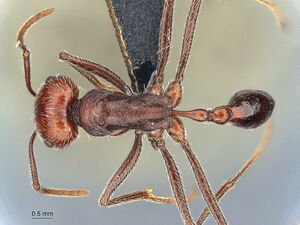Ocymyrmex phraxus
| Ocymyrmex phraxus | |
|---|---|

| |
| Scientific classification | |
| Kingdom: | Animalia |
| Phylum: | Arthropoda |
| Class: | Insecta |
| Order: | Hymenoptera |
| Family: | Formicidae |
| Subfamily: | Myrmicinae |
| Tribe: | Crematogastrini |
| Genus: | Ocymyrmex |
| Species: | O. phraxus |
| Binomial name | |
| Ocymyrmex phraxus Bolton, 1981 | |
Nothing is known about the biology of Ocymyrmex phraxus.
Identification
A member of the weitzeckeri group. Bolton and Marsh (1989) - In the original description the petiole node shape of phraxus was given as “a small node which is not sharply differentiated from the peduncle; the dorsum of the peduncle runs into the anterior face of the node without a marked change in slope.” This character is now known to be variable. The more recently acquired material shows some workers with the node almost as noted above, some with the anterior slope of the node obviously differentiated from the peduncle, and some of an intermediate shape.
Bolton (1981) - The non-paratypic series matches the type-series well but has sculpture slightly more intense in development and has some workers which are slightly smaller, HL 1.78-1.90, HW 1.70-1.82, CI 95-96, SL 1.54-1.64, SI 90-93. The sculpture of the petiole in phraxus is reminiscent of a reduced version of that found in Ocymyrmex sobek, but in the latter the node is greatly swollen and very distinctive, and the gaster is yellowish, much lighter than the alitrunk.
Keys including this Species
Distribution
Latitudinal Distribution Pattern
Latitudinal Range: -2.75° to -18.93469°.
| North Temperate |
North Subtropical |
Tropical | South Subtropical |
South Temperate |
- Source: AntMaps
Distribution based on Regional Taxon Lists
Afrotropical Region: Kenya, Mozambique, United Republic of Tanzania.
Distribution based on AntMaps
Distribution based on AntWeb specimens
Check data from AntWeb
Countries Occupied
| Number of countries occupied by this species based on AntWiki Regional Taxon Lists. In general, fewer countries occupied indicates a narrower range, while more countries indicates a more widespread species. |

|
Estimated Abundance
| Relative abundance based on number of AntMaps records per species (this species within the purple bar). Fewer records (to the left) indicates a less abundant/encountered species while more records (to the right) indicates more abundant/encountered species. |

|
Biology
|
Castes
Known only from the worker caste.
Worker
   
| |
| . | Owned by Museum of Comparative Zoology. |
Nomenclature
The following information is derived from Barry Bolton's Online Catalogue of the Ants of the World.
- phraxus. Ocymyrmex phraxus Bolton, 1981b: 274, fig. 27 (w.) TANZANIA. See also: Bolton & Marsh, 1989: 1301.
Unless otherwise noted the text for the remainder of this section is reported from the publication that includes the original description.
Description
Worker
Holotype. TL 7.9, HL 1.92, HW 1.82, CI 95, SL l.58, SI 87, PW l.15, AL 2.32.
Anterior clypeal margin with a deep median impression which is flanked on each side by a tooth. Sides of head in front of eyes more or less parallel, the head not broadening anteriorly. Maximum diameter of eye 0.38, about 0.21 x HW. Promesonotum forming an even, low convexity in profile which slopes gently downwards posteriorly. Propodeal dorsum rounding evenly into the declivity. Metapleural lobes low and rounded. Petiole in profile with a small node which is not sharply differentiated from the peduncle; the dorsum of the peduncle runs into the anterior face of the node without a marked change in slope. This surface is confluent behind with the dorsum, which is low and broadly evenly rounded. In dorsal view the node is narrow and almost parallel-sided, its maximum width not much greater than that of the posterior peduncle. Postpetiole longer than broad in dorsal view, discounting the anterior articulatory section. First gastral tergite constricted basally, forming a narrow neck behind the postpetiole. Dorsum of head densely sculptured with fine, sharply defined parallel longitudinal rugulae which are slightly divergent posteriorly and more divergent laterally where they tend to arch outwards behind the eyes. Spaces between the rugulae filled with a fine dense and conspicuous punctulate ground-sculpture. Pronotum with arched-transverse costulae, with a patch of longitudinal sculpture between the mesothoracic spiracles. Remainder of dorsal alitrunk transversely rugose except for a small disorganized patch between the propodeal spiracles. Alitrunk dorsally lacking the punctulate ground-sculpture seen on the head. Petiole with a number of very fine rugulae which encircle the node, the postpetiole only with fine superficial patterning, or light shagreening. Dorsal surfaces of head and alitrunk all with numerous hairs, those on the first gastral tergite much shorter and sparser than those on the alitrunk. Alitrunk a dark, deep red, dully shining. Head dark red but lighter in shade than the alitrunk, the contrast easily visible to the naked eye. Gaster blackish brown to black, darker than the rest of the body.
Paratypes. TL 7.7-8.0, HL 1.90-1.96, HW 1.80-1.86, CI 94-96, SL 1.56-1.60, SI 85-89, PW 1.14-1.16, AL 2.26-2.34 (5 measured). Maximum diameter of eye 0.36-0.38, about 0.20-0.21 x HW. As holotype but some with the petiole node slightly broader in dorsal view and with the disorganized rugular patch on the propodeal dorsum less obviously developed.
Type Material
Holotype worker, Tanzania: Shinyanga, viii.1949 (B. K. Coll.) (The Natural History Museum). Paratypes. 4 workers with the same data as holotype (BMNH, Musee d'Histoire Naturelle Genève,).
References
- Bolton, B. 1981b. A revision of six minor genera of Myrmicinae (Hymenoptera: Formicidae) in the Ethiopian zoogeographical region. Bull. Br. Mus. (Nat. Hist.) Entomol. 43: 245-307. (page 274, fig. 27 worker described)
- Bolton, B.; Marsh, A. C. 1989. The Afrotropical thermophilic ant genus Ocymyrmex (Hymenoptera: Formicidae). J. Nat. Hist. 2 23: 1267-1308.
References based on Global Ant Biodiversity Informatics
- Bolton B., and A. C. Marsh. 1989. The Afrotropical thermophilic ant genus Ocymyrmex (Hymenoptera: Formicidae). Journal of Natural History 23: 1267-1308.
- IZIKO South Africa Museum Collection


